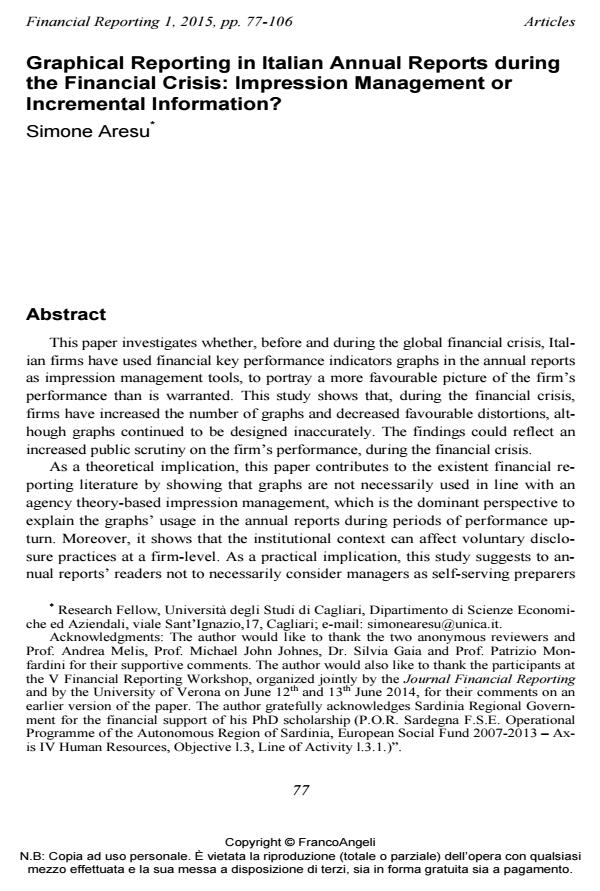Graphical Reporting in Italian Annual Reports during the Financial Crisis: Impression Management or Incremental Information?
Titolo Rivista FINANCIAL REPORTING
Autori/Curatori Simone Aresu
Anno di pubblicazione 2015 Fascicolo 2015/1
Lingua Italiano Numero pagine 30 P. 77-106 Dimensione file 346 KB
DOI 10.3280/FR2015-001004
Il DOI è il codice a barre della proprietà intellettuale: per saperne di più
clicca qui
Qui sotto puoi vedere in anteprima la prima pagina di questo articolo.
Se questo articolo ti interessa, lo puoi acquistare (e scaricare in formato pdf) seguendo le facili indicazioni per acquistare il download credit. Acquista Download Credits per scaricare questo Articolo in formato PDF

FrancoAngeli è membro della Publishers International Linking Association, Inc (PILA)associazione indipendente e non profit per facilitare (attraverso i servizi tecnologici implementati da CrossRef.org) l’accesso degli studiosi ai contenuti digitali nelle pubblicazioni professionali e scientifiche
This paper investigates whether, before and during the global financial crisis, Italian firms have used financial key performance indicators graphs in the annual reports as impression management tools, to portray a more favourable picture of the firm’s performance than is warranted. This study shows that, during the financial crisis, firms have increased the number of graphs and decreased favourable distortions, although graphs continued to be designed inaccurately. The findings could reflect an increased public scrutiny on the firm’s performance, during the financial crisis. As a theoretical implication, this paper contributes to the existent financial reporting literature by showing that graphs are not necessarily used in line with an agency theory-based impression management, which is the dominant perspective to explain the graphs’ usage in the annual reports during periods of performance upturn. Moreover, it shows that the institutional context can affect voluntary disclosure practices at a firm-level. As a practical implication, this study suggests to annual reports’ readers not to necessarily consider managers as self-serving preparers in their graphical reporting strategies. The study also suggests accounting associations, audit firms and other regulatory bodies to create a set of guidelines for a correct graph’s use and design.
Parole chiave:Financial crisis, financial key performance indicators graphs, impression management, incremental information.
- 2018 IEEE 42nd Annual Computer Software and Applications Conference (COMPSAC) Uthai Tanlamai, pp.327 (DOI:10.1109/COMPSAC.2018.00052)
- The blame game: COVID-19 crisis and financial performance Rayenda Khresna Brahmana, Doddy Setiawan, Maria Kontesa, in SN Business & Economics 173/2022
DOI: 10.1007/s43546-022-00352-w
Simone Aresu, Graphical Reporting in Italian Annual Reports during the Financial Crisis: Impression Management or Incremental Information? in "FINANCIAL REPORTING" 1/2015, pp 77-106, DOI: 10.3280/FR2015-001004